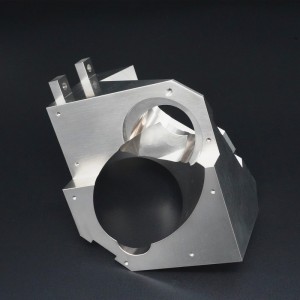1. Hole depth and diameter
Holes in most cases are interpolated with end mills, not drilled. This machining method offers great flexibility in hole size for a given tool and provides a better surface finish than drills. It also allows us to machine grooves and cavities with the same tool, reducing cycle time and part cost. The only downside is that due to the limited length of the end mill, holes deeper than six diameters become a challenge and may need to be machined from both sides of the part.
2. Size and type of thread
Drilling and thread making go hand in hand. Many manufacturers use a “tap” to cut internal threads. The tap looks like a toothed screw and “screws” into the hole previously drilled. We take a more modern approach to making threads, a tool called a thread mill inserts the thread profile. This creates precise threads and any thread size (threads per inch) that shares that pitch can be cut with a single milling tool, saving production and installation time. Therefore, UNC and UNF threads from #2 to 1/2 inch and metric threads from M2 to M12 can all be used in a single tool set.
3. Text on the part
Want to engrave a part number, description or logo on a part? Acceleration supports most of the text required for processing, provided the spacing between individual characters and the strokes used to “write” them is at least 0.020 inches (0.5 mm). Also, the text should be concave rather than raised, and a 20 point or larger font such as Arial, Verdana or similar sans serif is recommended.
4. Wall Height and Feature Width
All our knives consist of carbide knives. This ultra-rigid material provides maximum tool life and productivity with minimal deflection. However, even the strongest tools can deform, as can metals, and especially plastics being machined. Therefore, wall height and feature size are very dependent on the geometry of the individual parts and the toolset used. For example, a minimum feature thickness of 0.020″ (0.5mm) and a maximum feature depth of 2″ (51mm) are supported for machining, but that doesn’t mean you can design a finned heat sink with these dimensions.
5. Power tool lathe
In addition to our extensive milling capabilities, we also offer live tool CNC turning. The tool sets used on these machines are similar to those on our machining centers, except we don’t turn plastic parts right now. This means that eccentric holes, grooves, flats, and other features can be machined parallel or perpendicular (axial or radial) to the “long axis” of the turned workpiece (its Z-axis), and typically follow orthogonal parts fabricated on a machining center Same design rules. The difference here is the shape of the raw material, not the tool set itself. Turned parts such as shafts and pistons start out round, while milled parts such as manifolds, gauge boxes and valve covers are often not, using square or rectangular blocks instead.
6. Multi-axis milling
Using 3-axis machining, the workpiece is clamped from the bottom of the raw stock while all part features are cut from up to 6 orthogonal sides. Part size is larger than 10″*7″ (254mm*178mm), only top and bottom can be machined, no side setting! However, with five-axis indexed milling, it is possible to machine from any number of non-orthogonal edges.
Post time: Feb-15-2022

